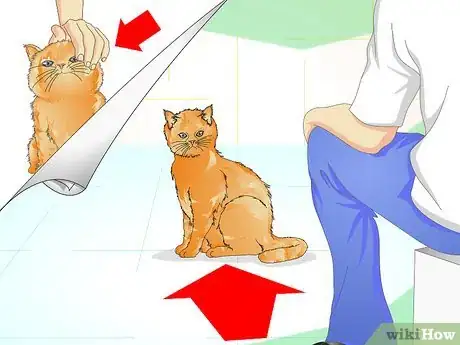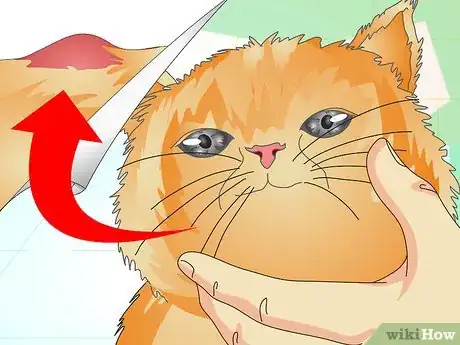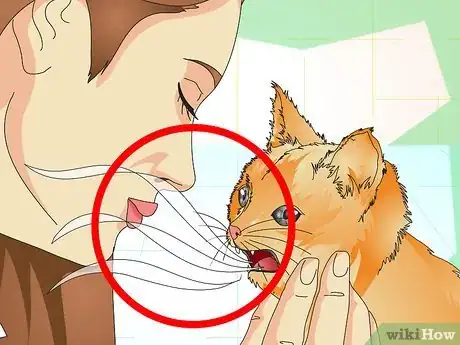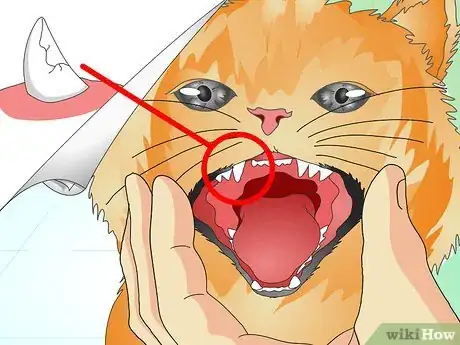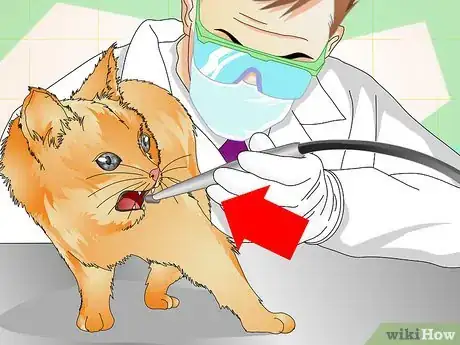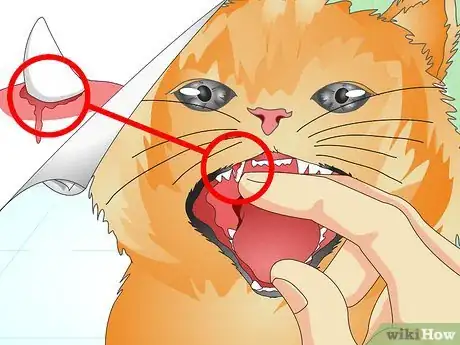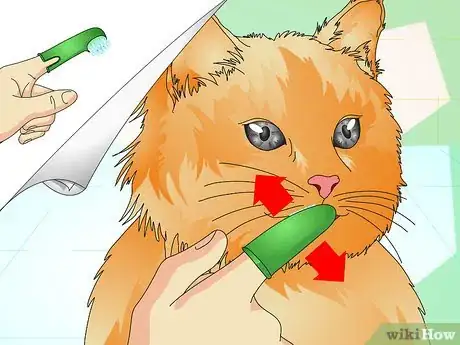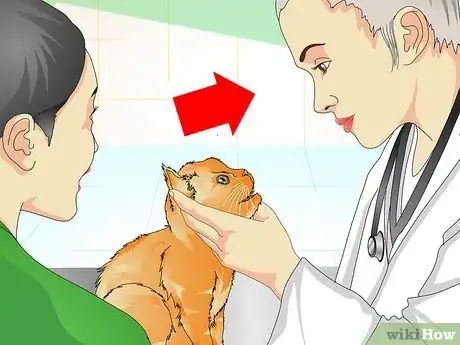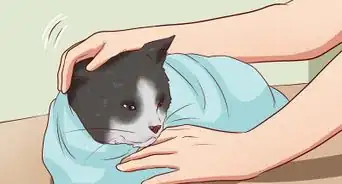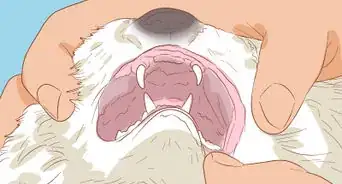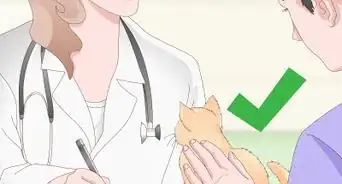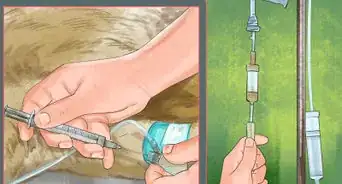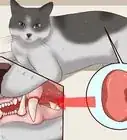This article was co-authored by Pippa Elliott, MRCVS. Dr. Elliott, BVMS, MRCVS is a veterinarian with over 30 years of experience in veterinary surgery and companion animal practice. She graduated from the University of Glasgow in 1987 with a degree in veterinary medicine and surgery. She has worked at the same animal clinic in her hometown for over 20 years.
This article has been viewed 39,095 times.
Healthy teeth and gums are important to your cat's overall health. You should check your cat's teeth at least once a month for signs of decay and disease. Have any unusual changes evaluated by your vet as soon as possible. You should also establish a dental hygiene routine for your cat that includes regular teeth cleaning.
Steps
Performing a Monthly Dental Check
-
1Approach your cat when he's calm. If your cat is normally friendly and affectionate with you, he should be fairly cooperative during a monthly dental check. However, make sure you catch your cat at the right moment. If you bother your cat when he's distressed, he may learn to associate his dental check with pain.
- Watch your cat's body language. A happy cat will have his ears forward and his tail held upward. His back may be arched or he may be lying on his side purring.[1]
- Pet your cat for a few moments before starting the dental check. Make sure he feels calm and happy going into the exam. Consider giving him a treat after you're finished. This can create a positive association with the exam. This may encourage him to better cooperate for its duration.
-
2Examine the face for swelling. To start, simply examine your cat's face. Swelling below the eyes can indicate a tooth abscess. Fractures along the canine teeth can cause swelling of the nose. Feel around your cat's neck and just above his ears as these areas may also swell due to dental problems.[2]Advertisement
-
3Smell your cat's breath. Once you've checked for swelling, gently open your cat's mouth. Pull his lips back using gentle force as not to cause pain or discomfort. Lean in and breathe in slightly through your nose. If you notice a foul odor, this could be a sign of gingivitis and should be evaluated by a veterinarian.[3]
-
4Look for fractures. After checking your cat's breath, open his mouth. Your cat may struggle during this process. Pause if necessary and soothe him by petting him and talking to him. Then, continue to pry his mouth open. Look over his teeth to check for any fractures.
- Chips, indents, and other signs of recent damage are a sign of a tooth fracture. If left untreated, this can result in infections and other complications.
- In the event you notice a fracture, take your cat to the vet for a check-up.[4]
-
5Check for tooth movements. If any of your cat's teeth are loose, this should be evaluated by your vet. Loose teeth are a sign of gum disease. Your cat may need medication and loose teeth might require medical removal. If your cat allows you to do so, gently press down on his teeth one by one. If you feel any movement, make an appointment with your vet for evaluation.[5]
Watching for Signs of Disease
-
1Take note of changes in behavior. You should do a dental check with your cat each month. However, you should also be on the lookout for changes in behavior. Behavioral issues in cats can be signs of an underlying dental health issue. Signs of teeth and gum disease in cats include:
- Lack of appetite
- Difficulty eating
- Clawing at the mouth[6]
-
2Watch for resistance during a monthly dental check. Most cats will resist dental examinations to some degree. Cats dislike having their mouths handled as it can be uncomfortable. However, if your cat seems particularly bothered by his monthly exam he may have a cavity or other dental health problem. A cat may growl or hiss in pain. He may also nip or scratch. If your cat seems particularly resistant one month, take him to a vet for evaluation.[7]
-
3Learn the physical signs of dental disease. There are a variety of physical signs that indicate dental disease. Keep an eye out for physical symptoms. Symptoms include the following:
- Redness of the gums
- Bleeding
- Pus or other discharge
- Salivation[8]
Maintaining Good Oral Hygiene
-
1Brush your cat's teeth regularly. Like people, cats need to have their teeth cleaned regularly. You can buy a toothbrush and toothpaste specifically designed for your cat at your vet's office. Brush your cat's teeth once a month to keep his mouth healthy.
- Cradle your cat from behind. Cup his chin and slowly lift up his lip. Use your kitty toothbrush to gently brush his teeth. If you don't have a kitty toothbrush, you can cover your fingertip with gauze and add a dab of cat-friendly toothpaste to the tip. Many people find simply using their fingers provides them with more control.[9]
- It might take awhile for your cat to get used to a teeth cleaning routine. Provide positive reinforcement in the form of praise and petting throughout the process. Consider giving your cat a small treat when you finish cleaning his teeth.
-
2Provide the right foods. For dental health, feed your cat a variety of wet and dry food. You should also provide him with deboned raw meat on occasion. This encourages chewing, which keeps his teeth bones strong. Fish, beef, and rabbit are good choices for your cat's dental health.[10]
- You can also give your cat bones as a treat. Bones help clear tartar off your cat's teeth. However, avoid fish, pork, or chicken bones. These could splinter when ingested, leading to internal injuries.[11]
-
3Let your veterinarian know about any concerns. If you notice bad breath or gum bleeding, let your vet know as soon as possible. Dental problems can lead to serious complications. Early intervention is key. If you see anything unusual during a routine dental check, call your vet and schedule an appointment.[12]
References
- ↑ http://www.humanesociety.org/animals/cats/tips/cat_communication.html
- ↑ http://www.veterinarypartner.com/Content.plx?A=162
- ↑ http://www.veterinarypartner.com/Content.plx?A=162
- ↑ http://www.veterinarypartner.com/Content.plx?A=162
- ↑ http://www.veterinarypartner.com/Content.plx?A=162
- ↑ http://www.yourcat.co.uk/Cat-health-advice/how-do-i-care-for-my-cat-s-teeth.html
- ↑ http://www.yourcat.co.uk/Cat-health-advice/how-do-i-care-for-my-cat-s-teeth.html
- ↑ http://www.yourcat.co.uk/Cat-health-advice/how-do-i-care-for-my-cat-s-teeth.html
- ↑ http://www.petmd.com/cat/slideshows/grooming/top-ten-tips-on-how-to-keep-your-cats-teeth-clean
About This Article
Before you check your cat’s teeth, pet it for a few moments to calm it down, which will make the exam go more smoothly. When your cat is relaxed, gently open its mouth and push its lips back with your fingers to expose its teeth. Then, lean in and smell your cats breath, as foul-smelling breath can be a sign of gingivitis. You should also look for any chips or indents in your cat’s teeth, which can indicate a tooth fracture and will require medical attention. If you notice any problems with your cat’s teeth, make sure to see your vet for treatment. To learn how to recognize signs of dental disease in your cat, read more from our Veterinary co-author.
